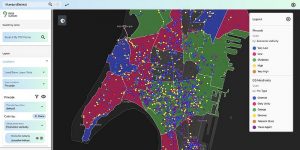Why hyperlocal intelligence is crucial for smart business planning
Traditionally, location has always been a mainstay of some of the biggest industries – be it retail, real estate or banking. But, with the onset of the COVID-19 pandemic, spatiality has begun to take centrestage like never before. Be it creating containment zones or planning vaccination drives, the only way to fight the pandemic has been to understand the ground reality rapidly and take decisive action. But, that’s not all. Today businesses across sectors are able to address some of the toughest business and operations challenges with a lot of help on leveraging location-based intelligence, more specifically hyperlocal intelligence.
Despite its relevance, hyperlocal intelligence has not been accorded its due significance until now. This is especially true in the Indian context, where pre-pandemic a lot of businesses across sectors didn’t really realise the necessity for a technology like hyperlocal intelligence, with the retail sector standing out as an exception. Even there, the use cases were limited to helping the businesses identify the right locations for their expansion plans, trying to understand which products needed to be stocked based on the usage in the area.
Why the universal nature of data aids in furthering hyperlocal intelligence
The data that hyperlocal intelligence relies upon is sector-agnostic; the insights or intelligence that is churned can be made sector-specific. For instance, while the data point on footfall doesn’t change irrespective of which sector you want to leverage the data for, that data point has different yet equally significant implications for different sectors – from retail, mobility to real estate.
As a startup that works at the intersection of Artificial Intelligence (AI) methodologies such as Optical Character Recognition (OCR) and Natural Language Processing (NLP) to uncover raw data sources and compute socio-economic parameters, we have been able to leverage this universal nature of data to fuel our B2B-Location Data Engine.
Data Sutram’s data engines clean, process, and geotag data from multiple sources and blend them together with AI and ML methodologies to create actionable, accurate data and insights for every location. Our data engines have the capability to handle data in any form, collected from any unstructured repository, and convert it to useful forms of data. It further marries the platform’s 200+ multiple data fields interactively to bring out over 150+ insightful indexes applicable to any geography at a fine, granular level, thus making it very comprehensive to understand and read. Its granular data and sector-specific customised verticals help reduce adaptability time for businesses to shift to data-driven decision making. The product’s architecture has a scope for end-mile customisation, thereby meeting the needs of businesses. And, our engagement with NetApp Excellerator has further helped to strengthen the platform by exploring some of NetApp’s key offerings in the area of snapshotting and security.
Today, businesses across are increasingly realising the need for hyperlocal intelligence with restricted movement and lockdowns, challenging the deployment of on-field workforce to tap into hyperlocal data for all business decisions. However, one of the least spoken use cases of hyperlocal intelligence has been in the merchant lending space. With the pandemic halting all non-essential business activity, recollection became a huge headache for financial lenders to understand exactly which merchants were most likely to default. They were forced to revisit the age-old questions that they had typically relied on to process the loan applications. It is here that location intelligence became relevant.

Armed with granular spending capacity, footfall, accurate merchant data location, etc, financial lenders were better equipped to make informed decisions. In addition, the financial companies were also able to track and acquire merchants virtually based on location indicators with little loan history and a non intrusive vetting process. As a startup that today has expertise in hyperlocal intelligence, we have been able to work with financial institutions, especially those with a focus on money lending to use location scorecards to evaluate and approve loan applications in a matter of minutes. Merchant payment companies have been able to onboard high potential merchants based on business activity of the location.
How hyperlocal intelligence works
The answer lies in understanding the two parts of hyperlocal intelligence – granular location data (locations DNA) and geo-spatial intelligence.
In today’s world, we are constantly being monitored by the various devices around us – starting from the cell phones in our hand to the satellites in the sky. These devices capture information about our movement, behaviour and how life is evolving. Creating the location data involves working with these multiple data sources like satellite, mobile mobility, places of interest, etc processing and blending them together to create indicators for consumer activity at a 100m granularity. The next part involves developing business intelligence and actionable insights by modelling the businesses’ key performance indexes, such as monthly store sales, loan risk, etc depending on the use case.
As a business, one of the advantages of using hyperlocal intelligence is limited dependence on end-customer data. For instance, in most use cases in merchant acquisition that seeks to identify demand or demand sensing as we call it, the end-customer’s data is only used to model on the location indicators so the bank or the NBFC can start off with little or no data.
That’s why today, hyperlocal intelligence presents itself as a tool that can answer some of the most standard questions that occur in the running of a business. Aggregating multiple sources of information, it is possible to now understand what is present out there in a location- human behaviour, supply bottlenecks, operational problems at a hyperlocal level all within a framework of anonymisation and safety. It helps to answer a number of questions. This includes a question such as is the location right for my business – be it for a bank planning to install an ATM machine, a food delivery service planning its cloud kitchen; is my field workforce knocking on the right doors – as in the case of a NBFC looking to target merchants; am I targeting the right people – as in the case of brands looking to identify consumer-ins and figuring out their purchase trends.
A shift that was long overdue
At a time when resources like hospital beds, ICUs, even services like ATMs have to be planned as per the ground reality, hyperlocal intelligence has a more significant role to play than ever before. But, this is true for businesses across, as they look to strategise to survive and thrive amidst a very challenging business environment. The pandemic has only catalysed this shift, but it’s one that has been long overdue. And, hyperlocal intelligence is set to drive the next big wave in the digital transformation narrative.
Blog Source: Yourstory

